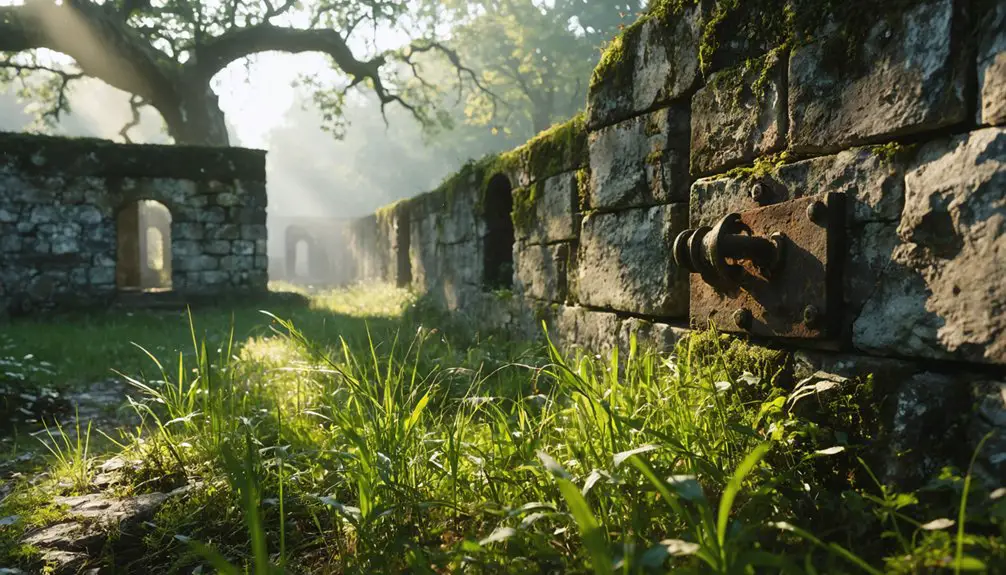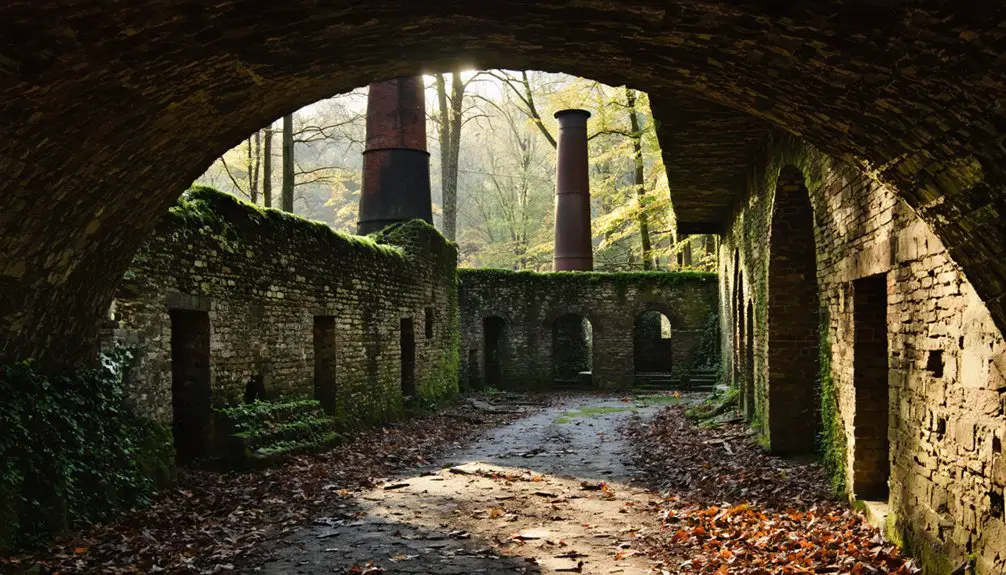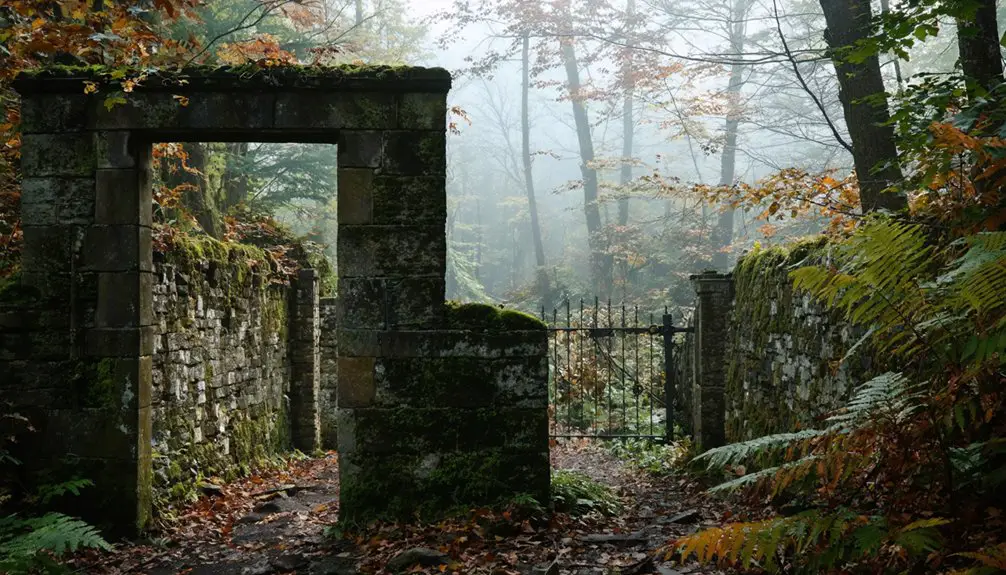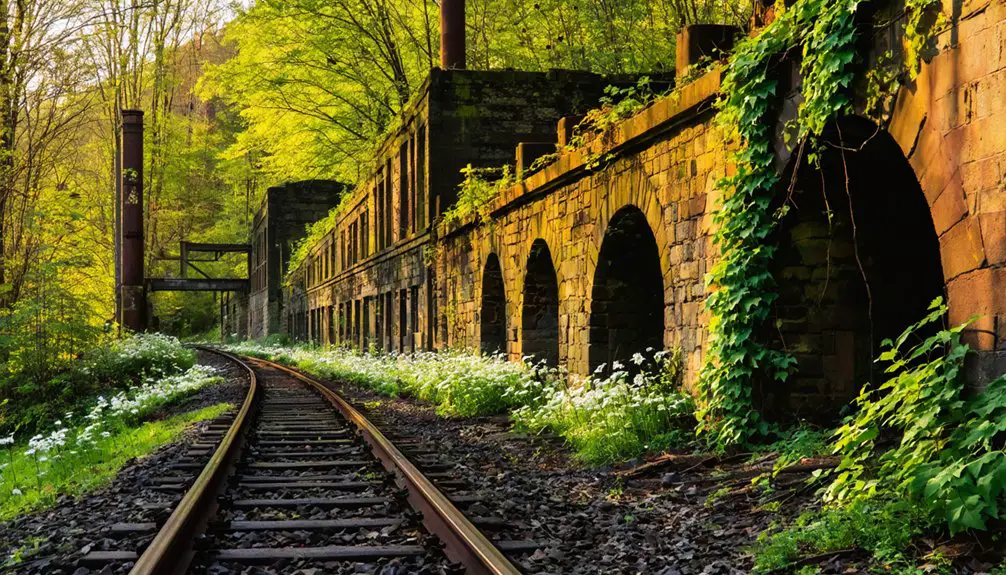You’ll find Yellow Springs nestled in Pennsylvania’s historic coal country, where natural mineral springs first drew health-seeking visitors in the 1700s. The village transformed from an exclusive spa resort into a thriving mining community in the 1850s, complete with innovative rail systems and extensive tunnel networks. By the 1870s, poor-quality coal and depleted timber resources led to its abandonment, leaving behind mysterious ruins in St. Anthony’s Wilderness that tell a deeper story.
Key Takeaways
- Yellow Springs transformed from a thriving spa resort and mining town to near-abandonment following the decline of coal mining and lumber operations.
- The town’s economic downturn began in the 1870s when poor-quality coal and depleted timber resources forced industries and workers to relocate.
- Most buildings deteriorated in the late 19th century as nature reclaimed the area, leaving scattered ruins in St. Anthony’s Wilderness.
- The closure of the Dauphin & Susquehanna Railroad severed crucial transportation links, accelerating the town’s decline and population exodus.
- Today, Yellow Springs has recovered with 155 residents and 70 modest homes, though its ghost town history remains evident in surrounding ruins.
The Birth of a Mining Settlement
While early European settlers first arrived in the Yellow Springs area under William Penn’s land grants in the 1700s, the settlement’s true birth as a mining community wouldn’t occur until the discovery of coal in the early 1800s.
You’ll find that the initial settlement patterns shifted dramatically as mining techniques evolved in the Stony Valley region, transforming Yellow Springs from an agricultural outpost into a bustling coal town.
As you explore the area’s history, you’ll discover that the village grew rapidly between the 1850s and 1870s, with miners establishing homes and businesses around the coal extraction sites.
Though the coal wasn’t of the highest quality compared to other Pennsylvania deposits, it still drew enough workers and industry to establish a thriving community during its peak mining years.
The decline in coal quality ultimately led to the village’s post-1870s abandonment, with most residents relocating to seek better opportunities elsewhere.
The village gained fame for its sulfur springs’ medicinal properties, attracting visitors who sought natural healing treatments at the popular summer resort.
Natural Springs and Healing Waters
You’ll find that Yellow Springs earned its name from the iron-rich waters that left distinctive yellow stains on the rocks and soil around the natural springs.
These mineral-laden waters, containing iron, magnesium, and sulfur, drew visitors seeking therapeutic treatments as early as the 18th century. The settlement quickly transformed into a fashionable resort town, with wealthy colonists traveling great distances to bathe in and drink from the springs that were believed to possess healing properties. Under the management of Margaret Holman in 1838, the spa continued to thrive as a popular destination for those seeking natural remedies. According to historical records, the springs were first used by Native Americans who recognized their medicinal value.
Mineral-Rich Spring Properties
Deep beneath the historic village of Yellow Springs, mineral-rich waters emerge from natural springs containing high concentrations of iron, magnesium, and sulfur.
You’ll notice the distinctive yellow coloration where iron-rich water settles on surrounding stones, a demonstration of the spring mineralization that’s remained consistent for centuries.
These waters share similar therapeutic properties with other colonial-era healing springs, flowing year-round into Pickering Creek from sustained underground systems.
A charming 1830s gazebo structure stands as an enduring monument to the spring’s historical significance.
The springs’ geological setting, typical of Eastern Pennsylvania, creates ideal conditions for mineral-water interaction within local rock formations.
You can still witness the natural chemistry at work as iron precipitates from the emerging waters, continuing a process that’s drawn health-seekers since before colonial times, when the Lenni Lenape people first recognized their healing potential.
The Diamond Spring contains particularly high levels of magnesium and remains one of the most notable water sources in the village.
Early Resort Town History
Before the Revolutionary War transformed its destiny, Yellow Springs emerged as one of colonial America’s premier health destinations due to its mineral-rich waters. You’d find visitors from across the colonies seeking cures in the sulfur and iron-rich springs, following healing traditions first established by the Lenape people.
The village quickly grew to accommodate wealthy guests, featuring grand hotels and an octagonal schoolhouse where community gatherings flourished alongside therapeutic treatments. Dr. Samuel Kennedy’s acquisition in 1774 brought new development and management to the thriving resort. Located just off Route 113, the village remains easily accessible to modern visitors interested in its rich history.
The springs’ reputation for medicinal properties drew those hoping to improve their health through drinking and bathing in the mineral-laden waters. Medicinal herb gardens complemented these therapeutic offerings, while the social atmosphere of the resort provided opportunities for leisure and rejuvenation in the tranquil Pennsylvania countryside.
The village’s early success established a cultural legacy that would evolve through centuries.
Revolutionary War Connections

When General George Washington arrived at Yellow Springs on September 17, 1777, he recognized the village’s strategic potential as a medical sanctuary for his wounded troops.
Washington’s keen eye saw Yellow Springs’ promise – a haven where his battle-weary soldiers could find healing and respite.
You’ll find this wasn’t just any military hospital – it became the first commissioned directly by the Continental Congress in North America, treating casualties from the essential Battles of Brandywine and Germantown.
Revolutionary medicine flourished here as the hospital’s proximity to Philadelphia proved indispensable during the British-American conflict.
The iron-rich mineral springs provided natural healing waters for the wounded soldiers during their recovery.
You can still walk among the stone ruins where Continental Army soldiers once recovered from historical battles.
The village’s strategic location transformed it from a peaceful spa resort into a significant military medical center, complete with medicinal herb gardens and support facilities that sustained Washington’s army throughout the Philadelphia campaign.
The facility remained operational until it closed in 1781, though it continued serving the local village afterward.
Peak Years and Economic Activity
You’ll find Yellow Springs’ peak economic activity centered around three major industries that defined different eras: first as an 18th-century spa resort town drawing visitors to its mineral-rich springs, then as a coal mining hub connected by the Dauphin & Susquehanna Railroad in the mid-1800s.
When mining proved unprofitable due to poor-grade coal, the town shifted to lumber operations, capitalizing on the surrounding timber resources and existing rail infrastructure.
The combined decline of mining, depletion of timber, and eventual closure of the railroad line marked the beginning of the town’s gradual abandonment, though institutions like the Soldiers’ Orphans School and Pennsylvania Academy of Fine Arts provided temporary economic lifelines.
Mining and Railroad Growth
During the 1850s, Yellow Springs transformed from a modest mining settlement into a bustling industrial hub after the construction of the Dauphin & Susquehanna Railroad. Engineers Miller and Charles R. Paxton designed an innovative system, including an inclined plane that revolutionized coal transportation from mountain drifts to the mainline.
You’d have found miners using evolving mining techniques, from basic hand labor and wheelbarrows to more sophisticated mine buggies on wooden tracks. The Fort Lookout, Beartown, and Big Flats mines drove deep into the mountains, with tunnels eventually stretching over 2,000 feet.
Spa Resort Heritage
Three natural springs, rich in iron, magnesium, and sulfur, established Yellow Springs as one of America’s premier health destinations by the mid-18th century.
You’d find visitors from as far as the West Indies seeking the healing practices centered around these mineral-rich waters. The spa culture flourished, drawing hundreds of daily bathers who believed in the waters’ medicinal properties.
You would have rubbed shoulders with Presidents Madison and Monroe, or caught performances by Jenny Lind at the resort’s peak.
The village’s infrastructure expanded to meet demand, with multiple bathhouses and impressive buildings connected by wooden piazzas.
Even after briefly serving as Washington’s headquarters and hosting America’s first military hospital during the Revolution, Yellow Springs returned to its roots as a celebrated health resort, rivaling European spa destinations in both reputation and natural beauty.
Timber Industry Transition
As Yellow Springs evolved beyond its spa resort origins, the surrounding forests became an essential economic engine, powering one of America’s most significant timber booms in the 19th century.
You’d have witnessed bustling sawmills processing white pine, hemlock, and hardwoods, while “boom rats” managed massive log drives along the Susquehanna River system.
The region’s timber industry thrived through an intricate network of tramways and narrow-gauge railroads connecting mountaintop cutting zones to processing facilities.
You could’ve seen splash dams controlling water flows and the impressive Susquehanna Boom holding 300 million board feet of logs.
However, aggressive logging practices led to rapid timber decline by the 1920s, with Pennsylvania’s once-pristine forests stripped nearly bare, forcing many local mills to close and transforming the area’s economic landscape forever.
The Decline and Abandonment
While Yellow Springs initially thrived as a coal mining village in the 1850s along Sharp Mountain, the poor quality of its coal reserves ultimately spelled doom for the settlement.
Economic factors started working against the town by the 1870s as superior coal deposits elsewhere attracted both industry and workers away from the area.
You’ll find that the town’s decline accelerated when the Dauphin & Susquehanna Railroad ceased operations, severing crucial transportation links.
Population migration followed swiftly as residents sought better opportunities in neighboring communities.
Once-hopeful residents left in droves, abandoning their mountain home to chase dreams in more prosperous towns nearby.
While Yellow Springs briefly shifted into a lumber camp, this couldn’t sustain the community’s former liveliness.
By the late 19th century, most buildings had fallen into disrepair, with nature reclaiming the site.
Today, only scattered ruins and a mysterious stone tower remain in the St. Anthony’s Wilderness.
Notable Structures and Remnants

The most prominent feature you’ll encounter at Yellow Springs today is the mysterious stone tower that rises from the wilderness, standing as a tribute to the town’s mining heritage. This ventilation chimney once drew fresh air into the coal mines below while expelling stale air through its heights.
As you explore the site, you’ll discover scattered stone foundations marking former homes and community gathering spots. The mining infrastructure remains visible through deep pits and shaft locations, including the area where a steam shovel nicknamed “the General” once operated.
While most structures have surrendered to nature’s advance, you can still trace the village’s layout through remaining road beds and building outlines. Stone hearths and masonry ruins hint at the communal life that once thrived in this remote mining settlement.
Life in Modern Yellow Springs
Despite its ghost town reputation, modern Yellow Springs in Blair County has evolved into a small but growing community of 155 residents.
You’ll find a population that’s grown dramatically since 2020, with a 6.9% annual growth rate transforming this once-abandoned settlement. Today’s residents enjoy above-average household incomes of $77,724, though they’ll likely commute to nearby towns for work.
Life here centers around 70 modest homes valued around $116,000, where community engagement often focuses on preserving local traditions.
While amenities are limited, you’ll discover a close-knit community where neighbors know each other well. The median age of 41 suggests a stable adult population, though you won’t find much ethnic diversity in this mainly White settlement.
Most residents have vehicles, essential for accessing services in surrounding areas.
Legacy and Cultural Impact

Yellow Springs carries a rich historical tapestry stretching back to Pennsylvania’s founding in 1681, with each era leaving its mark on American history.
From its origins as a healing spa resort to its role as America’s first military hospital during the Revolutionary War, you’ll find layers of significance at every turn.
Today, cultural preservation efforts have transformed Yellow Springs into a vibrant hub of history and arts.
You can explore the historic ruins, wander through the 18th-century medicinal herb garden, or join the artistic community in fine art, sculpture, and ceramic classes.
The village’s commitment to education and environmental stewardship guarantees its legacy continues to inspire new generations.
Whether you’re attending an art show, celebrating a wedding, or hiking the surrounding trails, you’re participating in over three centuries of evolving American heritage.
Frequently Asked Questions
Are There Any Documented Paranormal Activities or Ghost Sightings in Yellow Springs?
While ghost encounters are frequently reported near the stone tower and old foundations, there’s no official documentation of paranormal activity – just haunting legends linked to an 1878 train accident and miners’ deaths.
What Wildlife Species Can Visitors Commonly Encounter in the Abandoned Town?
During wildlife observation, you’ll spot white-tailed deer, raccoons, foxes, and various songbirds. Look for animal tracks near springs, where eastern box turtles and salamanders often gather to drink.
Is Metal Detecting or Artifact Collecting Allowed at Yellow Springs?
You’ll need permission for metal detecting since regulations vary based on property ownership. Artifact collection guidelines strictly prohibit removing historical items over 100 years old, and you must report significant finds.
What Seasonal Changes Affect Accessibility to the Yellow Springs Ruins?
You’ll encounter muddy spring trails, dense summer vegetation, autumn leaf cover, and winter’s icy paths. Trail maintenance varies seasonally, with natural hazards and weather affecting your access year-round.
How Safe Is the Drinking Water From the Original Springs Today?
You shouldn’t drink directly from the original springs today – they’re untested and unmonitored. While the area’s water quality was historically notable, modern spring history shows they’re no longer maintained for safe consumption.
References
- http://paoddities.blogspot.com/2020/04/a-tragedy-in-yellow-springs.html
- https://news.chescoplanning.org/historic-yellow-springs-provides-glimpse-into-the-past/
- https://yellowsprings.org/historic-yellow-springs/
- https://hemlockstateexplorer.com/yellow-springs/
- https://www.ghosttowns.com/states/pa/yellowsprings.html
- https://www.earthspeak.net/pages/school-house-history
- https://www.youtube.com/watch?v=KcMe_q8-m3M
- https://www.ybwatershed.org/history
- https://davenkathy.blogspot.com/2014/12/historic-yellow-springs.html
- https://findingaids.library.upenn.edu/records/legacy/SMREP_HYS01



